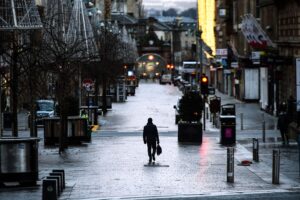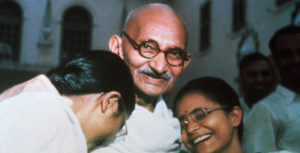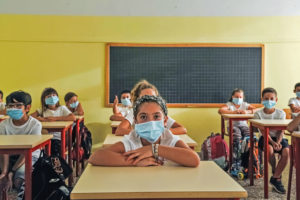All his life, 15-year-old Rehan Shaikh was known as a quiet, respectful, promising boy. His teachers praised him, frequently telling his mother how bright his future was going to be. In his hometown of Anjangaon, in central India’s Wardha district, he threw himself into sport and local festivities.
Yet for the past two years, he has hardly been seen. Stuck at home during the pandemic and shackled by his family’s financial insecurity, Shaikh abandoned education in 2021. Since then, he has been working on haulage trucks, transporting goods to nearby cities as a “cleaner”, assisting the driver and maintaining the truck. Once an outgoing teenager, now Shaikh only visits home every few days, often for just a few hours between trips. His childhood, as he knew it, is over.
Shaikh’s story is far from unique. Three years on from the pandemic, the entire world is still reeling from its effects. But in India, the restrictions were particularly extreme: in March 2020, when the whole world was shutting down, the Modi government imposed what became one of the world’s harshest lockdowns. With just four hours’ notice, more than a billion people were confined to their homes — and 1.5 million schools were closed. The country’s 247 million children were then condemned to “online” learning, little more than a euphemism in a country where only a quarter of students had any internet access. The long-term social effects of lockdown are slowly becoming apparent across the world — but in India, where education was already stratified by savage disparities of wealth and resources, its crippling consequences are already devastatingly clear.
In the region where Shaikh lived, smartphones and the internet were even scarcer than the Indian average. Local activists say internet coverage stood at less than 5%. “That’s when we realised that it was futile to think that we could deliver education digitally in rural India,” says Rahul Bais, who set up Swarajya Mitra, a local not-for-profit that campaigns for children’s rights. But while those on the ground like him realised the futility of online education, the Indian government pushed ahead. In a statement in August 2021, the Modi government highlighted the steps it had taken to ensure “no loss of education” during the pandemic. Topping the list was a government website named “DIKSHA” which hosted material such as school textbooks, educational TV and radio programmes, and YouTube videos.
Except, in areas like Wardha, none of it could reach students. S.S. Athawale, the principal of a government-funded secondary school in the area, the Dr Devidas Karale Vidhyalaya, explains: “Of, say, 100 students, only 20-25% of the children’s families had mobile phones. But 10% had analogue phones, and the 10% who had smartphones had no money to top-up their data. So, we were really able to reach only 5% of the children, depriving the remaining 95% of even basic education.” And even when students had both smartphones and the money for a data plan, the patchy internet connectivity in their villages stymied their efforts. Many students, faced with the seemingly indefinite interruption of their education, simply lost interest in their studies or turned to work to support their struggling families. When schools finally reopened for offline education in 2022, students in Shaikh’s position never returned.
And the effects of this are already tangible. A countrywide study, the 2022 Annual Status of Education Report, which surveyed more than 700,000 Indian children, found that children’s basic reading abilities had deteriorated to levels last seen in 2012, while their basic arithmetic skills had also regressed sharply to levels lower than in 2018. In another survey of school teachers in Jharkhand, one of India’s poorest states, 53% admitted that most of their pupils had forgotten how to read and write.
Shaikh’s story echoes across the villages of Wardha. Overnight, the pandemic forced many children to become adults. In the tiny village of Kinhala, just a 20-minute drive from the state highway, the single road barely sees any traffic. Instead, throughout the day, the road sees a steady stream of young children, mostly girls, walking up and down the street with steel pots. The village’s common source of water is a well, around 600 metres away from the village. Children who dropped out of school now find themselves huddled around the well several times a day, waiting for their turn to draw water.
Among them are 16-year-olds and best friends Amruta Shelke and Nikita Dabhekar, both of whom are no longer at school. Shelke’s mother passed away after an illness two years ago, coinciding with the pandemic. Since then, she has had to shoulder the burden of running the household while her father Prakash works in the family’s farm, cultivating cotton and soybean. “He looks after the farm while I take care of the household duties like cooking and cleaning and tend to the cattle,” Shelke says, standing outside the hay-roofed cattle shed adjoining her home.
Her friend Dabhekar has a similar story. Her father died during the pandemic, threatening the family’s financial stability. Debhekar had no choice but to work full-time as a labourer in the farms, earning £1.50 a day for a seven-hour shift. For years, Dabhekar had been straddling the world of labour and education — she would work for a week or so, before going to school for a couple of days and then back to work. But the pandemic disrupted this cycle of intermittent educational forever. She hasn’t given up on her education yet. But, she says, “we’ve just not been able to make enough money, so I have to keep working”.
Although similar stories abound across the region, official government data stubbornly refuses to reflect the self-evident crisis. Last year’s government report claimed that more than 785,000 additional students were enrolled in schools at all levels, from pre-primary to secondary, between April 2021 and March 2022 when compared to enrolment the previous year. But this claim relies on dubious data-keeping practices, as local teachers and principals admit. “Even when we know that a student is unable to come, we keep their names on the rolls because, that way, they’ll be easily able to come back whenever they want,” said a teacher at a secondary school in the area, who did not want to be named.
According to his mother, Shaikh himself, who has not been to school since 2020, is still on the school’s rolls as a student, and is officially in the tenth grade. Students like him only visit school to appear for examinations and are often allowed to go through the years without a strict test of their abilities. Teachers insist that such steps are taken out of compassion for students, but local activists say this “compassion” also conveniently allows schools to escape scrutiny for their absentee students.
Bais argues that many in Shaikh’s position have at this point lost interest in schooling, having instead tasted the freedom that earning a salary brings. And others are put off returning by the sense that they have fallen irretrievably behind their peers. “We tried to re-enroll students who had dropped out, but we realised that they were too anxious about how other students around them would make fun of their ignorance,” Bais says. “The pandemic has shattered their confidence.” Shaikh’s mother Rehana, who had steadfastly refused to let her children work, have had no choice but to acquiesce to their children’s wishes. “My son tells me when we need money, no one will help us. So let me go and earn,” she says.
In a country that is both the world’s largest democracy and an aspiring superpower of the coming century, the long-term implications of this silent crisis could be stultifying. “After the pandemic pushed children into earning a living, many children started wondering why education was even necessary,” says Bais. “They would see their parents were doing similar work. As a result, many children asked us, ‘if we have to grow up and do this exact same work, why even bother finishing our education?’” Three years later, this is the true effect of lockdown in rural India — one that will take years to remedy.
***
The Children of Nowhere is released today.
Disclaimer
Some of the posts we share are controversial and we do not necessarily agree with them in the whole extend. Sometimes we agree with the content or part of it but we do not agree with the narration or language. Nevertheless we find them somehow interesting, valuable and/or informative or we share them, because we strongly believe in freedom of speech, free press and journalism. We strongly encourage you to have a critical approach to all the content, do your own research and analysis to build your own opinion.
We would be glad to have your feedback.
Source: UnHerd Read the original article here: https://unherd.com/




